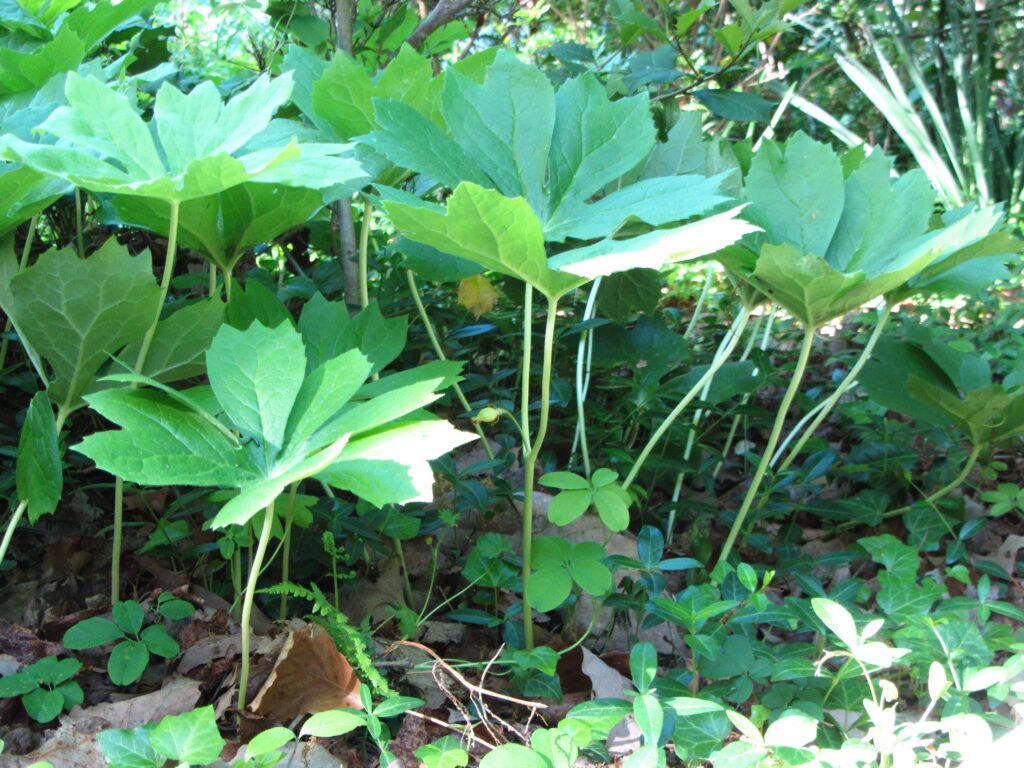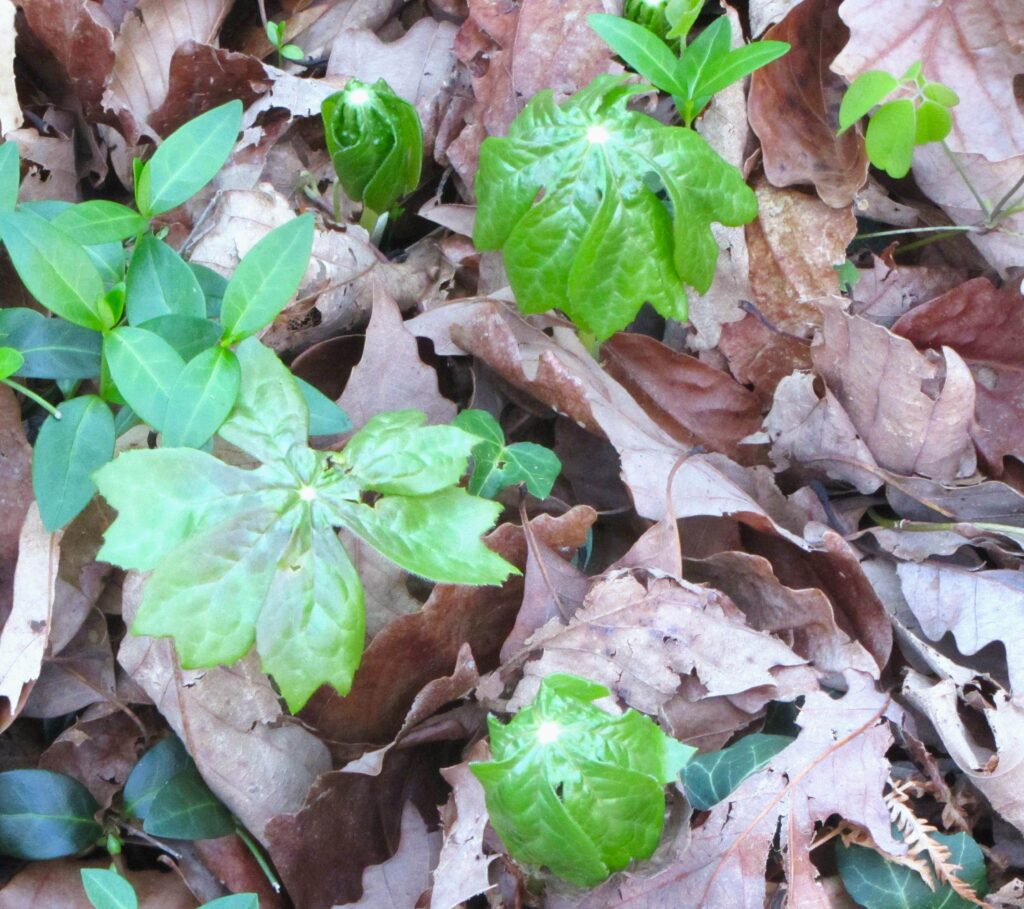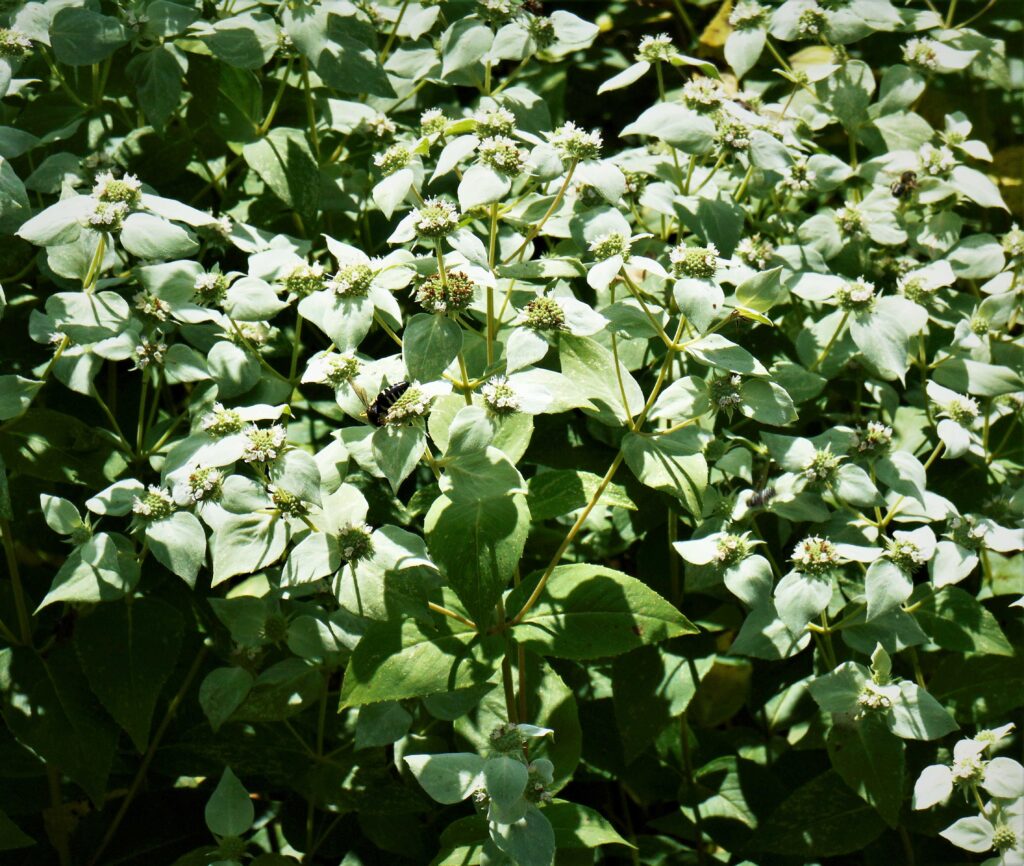Featured Plants for 2025
Let’s celebrate some of our more unusual and lesser-known native wildflowers in 2025. The Virginia Native Plant Society has chosen the Mayapple, Podophyllum peltatum, as its 2025 Wildflower of the Year. The Perennial Plant Association has also chosen a native wildflower, indigenous to Virginia, as its pick for 2025.
Perennial Plant of the Year for 2025
The 2025 Perennial Plant of the Year is clustered mountain mint, Pycnanthemum muticum, a native wildflower in the mint, or Lamiaceae family. It attracts pollinators and repels deer, rabbits, and some biting insects. It is one of seven native Pycnanthemum species found in Virginia, and along the East Coast and west into central North America. Its leaves, which were used medicinally by Native Americans, can be brewed as a minty herbal tea. All parts of the plant are edible, though only the flowers and leaves are used for tea. Mountain mint leaves may be rubbed on the skin to repel biting insects.
Clustered mountain mint is Hardy in Zones 4-8 and grows on most any fertile moist soil in full to partial shade. It is a persistent, relatively disease-free perennial which spreads itself around the garden on rhizomes, weaving among other plantings to eventually form dense mats of deciduous growth to 4’ tall. Many appreciate this plant for its silvery, neat leaves as well as for its ability to attract a wide variety of pollinators. Birds feed on the many insects attracted to mountain mint and later on its seeds.
Mountain Mint for Summer Gardens
Mountain mint blooms during the hottest part of summer from July through September. It is both drought and moisture tolerant and thrives in heat and humidity. Its tiny white to light pink flowers are individually small and inconspicuous, as with many members of the mint family. But they grow in clusters surrounded by silver bracts which persist after the flowers fade. Stems may be left standing through the winter as the seeds ripen.
The Perennial Plant Association announced Pycnanthemum muticum as its 2025 pick at its 2024 PPA National Symposium on July 31 in Asheville, North Carolina. Selected by PPA members, this wildflower is native to meadows and open woodlands across much of the eastern United States. It supports a variety of native insects, providing rich nectar over a long season. Once established this hardy native perennial needs little additional fuss or care. Cut any remaining stems back in early spring to make way for new growth. Shovel prune new rhizomes to control the plant’s spread or dig out clumps to plant elsewhere in your garden.
The Virginia Native Plant Society’s Wildflower of the Year for 2025
The VNPS Board chose the spring ephemeral wildflower, Podophyllum peltatum, as its wildflower for 2025. Any member may nominate a wildflower that is native to Virginia as long as it isn’t considered an invasive pest or an obnoxious weed. The Botany Chair oversees the Board’s selection process each year in their search for an indigenous plant that grows throughout Virginia and will be interesting to the VNPS’s membership for its beauty, ecological niche, historical significance, or for some other interesting feature.
You may recognize Mayapple instantly by its large, lobed leaf which usually hides its single flower and later a small fruit. ‘Podophyllum’ means ‘foot-leaf,’ and indeed this is the ‘big foot’ of early spring perennial leaves. Mayapple is usually among the first perennials to emerge in spring with each stem holding one, or perhaps two leaves. Those stems with two leaves usually have a single white or light pink flower nestled between them. These flowers produce rich pollen but no nectar. Yet pollinating insects still visit these hard to find flowers to harvest their pollen, and an edible fruit develops by mid-May.

A small fruit begins to develop on a mayapple plant by late April. Notice the stem with two leaves is the only one with a developing fruit.
A Poisonous Plant that Deer Avoid
All parts of the mayapple plant are highly poisonous, except its ripe fruit. The fruit is poisonous until fully ripe, when it is softened and yellow. It is said to have a bland flavor, like melon. Known also as American mandrake, Indian apple, umbrella leaf, and hog apple; Native Americans used parts of this plant medicinally in small, non-lethal amounts. This plant is so poisonous that handling the leaves and root without gloves may cause skin irritation in some people.
But these same poisonous substances allow large colonies of mayapple to grow undisturbed by deer, rabbits, or other animals in wooded areas throughout Virginia and along the East Coast of North America from Nova Scotia to Texas in Zones 3-8. Mayapple grows best in deep to partial shade on rich, moist loam or sand. A true wildflower, a gardener needs to do little besides admire it, and let it be.
Propagating Mayapple
Mayapple grows to around 12”- 15” tall, depending on the cultivar, and spreads on its rhizomes to form an ever-expanding clonal colony. It may be propagated by division in the fall by carefully digging a clump of rhizomes from the edge of an established patch. Mark plants in June, as they die back, so you remember where to dig up plant divisions in autumn. Mayapple can also be grown from collected, fully ripe seeds, but they require a winter of cold stratification before germination. This plant needs several years to mature from seed. This requires some organization and persistence on the part of the gardener since mayapple plants disappear by mid-summer and remain dormant through more than half of the year.
Some nurseries that specialize in native plants may carry named cultivars of mayapple, such as Plant Delights 2004 introduction of P. peltatum ‘Maid Marion’ collected from Marion County, TX, just northwest of Shreveport LA. They also introduced P. peltatum ‘Wagon Wheels,’ a fancy variegated variety collected in GA, in 2024. But many of the mayapple plants available commercially are hybrids or selections of Chinese, or other Asian mayapple species. Check the species of mayapple plants before purchasing, and also check to see how the nursery propagates its plants. It is better to purchase nursery propagated plants than to purchase plants collected from the wild for resale.

Mayapples emerge from the ground folded much like umbrellas, unfurling each leaf slowly over several days. The entire colony is a single, clonal plant connected underground by its network of rhizomes.
Plant Mayapple in Shady Wildlife Gardens
Mayapple is best used as an ephemeral ground cover plant in a naturalistic, wooded garden. It serves as a host plant for the Variegated Fritillary butterfly and for several moth species. Box turtles, squirrels, and other small animals eat its fruit, and it offers habitat for small animals like toads and turtles as they emerge in spring through early summer. Songbirds hunt for insects under its leaves. It doesn’t like full sun, doesn’t need fertilization, will only need irrigation if there is a severe spring drought, and doesn’t need any deadheading or pruning. Some might consider it a nearly perfect native plant for the shade garden, except its season is all too short.
Mountain mint and mayapple are both excellent native plant choices for many gardens in coastal Virginia. Both offer attractive foliage, support native insects, discourage deer, and require little care or attention. Since they are both featured selections this year, plants should be easier to locate at local garden centers and through online plant nurseries.
All photos by E. L. McCoy






